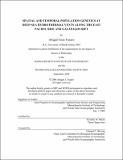Spatial and temporal population genetics at deep-sea hydrothermal vents along the East Pacific Rise and Galápagos Rift
Author(s)
Fusaro, Abigail Jean
DownloadFull printable version (4.869Mb)
Other Contributors
Woods Hole Oceanographic Institution.
Advisor
Timothy M. Shank.
Terms of use
Metadata
Show full item recordAbstract
Ecological processes at deep-sea hydrothermal vents on fast-spreading mid-ocean ridges are punctuated by frequent physical disturbance. Larval dispersal among disjunct vent sites facilitates the persistence of sessile invertebrate species in these geologically and chemically dynamic habitats despite local extinction events. Regional population extension and rapid recolonization by the siboglinid tubeworm Riftia pachyptila have been well documented along the East Pacific Rise and the Galápagos Rift. To analyze spatial and temporal population genetic patterns and the processes governing them at ephemeral and disjunct habitats, a suite of 12 highly variable microsatellite DNA markers were developed for this species. Eight of these loci were used to assess the regional and within-ridge genetic structure of recent colonists and resident adults collected from nine sites in the eastern Pacific Ocean over period of three to seven years. A significant seafloor eruption during the seven-year sampling period allowed investigation into the role of local extinction in population genetic diversity at the Tica vent site at 9°N EPR, while collections within two and five years of an eruption that created the Rosebud vent field at 86°W GAR provided insights into genetic diversity input over population establishment. For the first time, this thesis demonstrated significant genetic differences between Riftia populations on the East Pacific Rise and Galápagos Rift. Moreover, the separate treatment of colonist and resident subpopulations revealed a high potential for local larval retention at vent sites. This mechanism for recruitment likely sustains disjunct populations and supports the recolonization of locally extinct areas after disturbance events, while episodic long-distance dispersal maintains genetic coherence of the species. (cont.) Temporal population genetic consideration at the Tica site on the East Pacific Rise suggests that the 2005-2006 seafloor eruption had little to no discernable effect on local population genetic composition. Yet local populations appear to exhibit a small degree of genetic patchiness, with a high degree of relatedness (half-sibs) among subsets of individuals within both colonist and resident cohorts. This thesis broadens the application of recently developed molecular techniques to study the effect of ridge-crest processes and offers new perspectives into marine dispersal, gene flow, and population differentiation.
Description
Thesis (Ph. D.)--Joint Program in Oceanography/Applied Ocean Science and Engineering (Massachusetts Institute of Technology, Dept. of Biology; and the Woods Hole Oceanographic Institution), 2008. This electronic version was submitted by the student author. The certified thesis is available in the Institute Archives and Special Collections. Includes bibliographical references.
Date issued
2008Department
Joint Program in Oceanography/Applied Ocean Science and Engineering; Woods Hole Oceanographic Institution; Massachusetts Institute of Technology. Department of BiologyPublisher
Massachusetts Institute of Technology
Keywords
Biology., /Woods Hole Oceanographic Institution. Joint Program in Oceanography/Applied Ocean Science and Engineering., Woods Hole Oceanographic Institution.